Newsstand Period 1922 - 1955
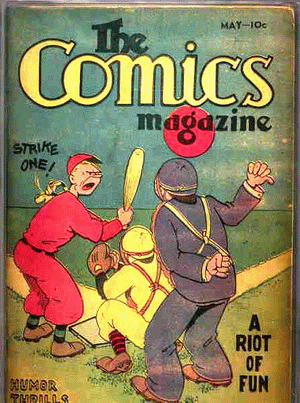 In May of 1936 two men named William Cook and
John Mahon
published The Comics Magazine #1. Cook and Mahon were former
disgruntled employees of Wheeler-Nicholson. They were the editor and
business manager of National Allied Publications. The two would
go on to form a publishing company called Comics Magazine but the title
changed and so did the ownership. Eventually it would be called Centaur
Comics. The Comics Magazine #1 would feature many of the same artists
that were in Wheeler-Nicholson’s books. Among them was Siegel and Shuster,
the two that would go on to create Superman. They renamed Dr. Occult to Mr.
Mystic and actually gave him supernatural powers, but no flashy
costume. The character would later appear in DC Comics More Fun #14,
with the story (called "The Koth and the Seven") continuing on from one
publishers book to the next. Another Siegel and Shuster character to
appear in this title was Federal Agent, later renamed Federal Men when
they also appeared in DC Comics. The Comics Magazine would change it's
name to Funny Pages with issue #6. The title would last until 1940
ending with issue #42.
In May of 1936 two men named William Cook and
John Mahon
published The Comics Magazine #1. Cook and Mahon were former
disgruntled employees of Wheeler-Nicholson. They were the editor and
business manager of National Allied Publications. The two would
go on to form a publishing company called Comics Magazine but the title
changed and so did the ownership. Eventually it would be called Centaur
Comics. The Comics Magazine #1 would feature many of the same artists
that were in Wheeler-Nicholson’s books. Among them was Siegel and Shuster,
the two that would go on to create Superman. They renamed Dr. Occult to Mr.
Mystic and actually gave him supernatural powers, but no flashy
costume. The character would later appear in DC Comics More Fun #14,
with the story (called "The Koth and the Seven") continuing on from one
publishers book to the next. Another Siegel and Shuster character to
appear in this title was Federal Agent, later renamed Federal Men when
they also appeared in DC Comics. The Comics Magazine would change it's
name to Funny Pages with issue #6. The title would last until 1940
ending with issue #42.
Comics Magazine #1 is in the public domain and you can download and read it by clicking here. (56.3 MB - Scanned Microfiche)
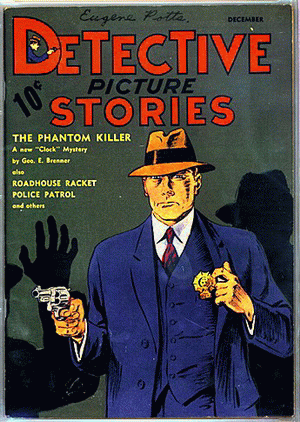 Comics Magazine would also be the first publisher to do comic
books based on specific genres. They were Detective Picture Stories,
Western Picture Stories, and Funny Picture Stories. Despite the title,
Funny was about Adventure type stories. Detective Picture Stories would
last 5 issues and they would include some work by creators who later
become famous like Will Eisner and Bob Kane. The title may have
continued on with another name but the specifics are not known. Funny
Picture Stories did better, but they kept ending and restarting the series.
There were 3 volumes, the 1st went 9 issues, the
2nd went 11 issues and the 3rd would go 3 issues before the title gets
renamed to Comic Pages from #4 and up. This series also had work from
people who later become famous, among them Charles Biro and Bob Wood
best known for the Crime Does Not Pay comic and Fred Guardineer who did a
lot of work for DC Comics. Lastly, Western Picture Stories lasted 4
issues. All with Will Eisner work in them.
Comics Magazine would also be the first publisher to do comic
books based on specific genres. They were Detective Picture Stories,
Western Picture Stories, and Funny Picture Stories. Despite the title,
Funny was about Adventure type stories. Detective Picture Stories would
last 5 issues and they would include some work by creators who later
become famous like Will Eisner and Bob Kane. The title may have
continued on with another name but the specifics are not known. Funny
Picture Stories did better, but they kept ending and restarting the series.
There were 3 volumes, the 1st went 9 issues, the
2nd went 11 issues and the 3rd would go 3 issues before the title gets
renamed to Comic Pages from #4 and up. This series also had work from
people who later become famous, among them Charles Biro and Bob Wood
best known for the Crime Does Not Pay comic and Fred Guardineer who did a
lot of work for DC Comics. Lastly, Western Picture Stories lasted 4
issues. All with Will Eisner work in them.
Detective Picture Stories #1 is in the public domain and you can download and read it by clicking here. (26 MB - Scanned Microfiche)
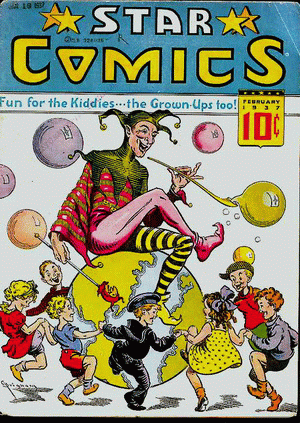 Harry "A" Chesler comic factory only had two clients. Those were
National Allied Publications and The Comics Magazine company. He then
decided to become a publisher himself. He put out two comics with the
cover date of February 1937. They were Star Comics and Star
Ranger. Other comic factories like this would also decide to
become comic publishers in the future. Chesler would sell these titles to another publisher
but would go back into publishing in 1941.
Harry "A" Chesler comic factory only had two clients. Those were
National Allied Publications and The Comics Magazine company. He then
decided to become a publisher himself. He put out two comics with the
cover date of February 1937. They were Star Comics and Star
Ranger. Other comic factories like this would also decide to
become comic publishers in the future. Chesler would sell these titles to another publisher
but would go back into publishing in 1941.
Behind the Scenes - What’s with the "A" ?
Harry would tell people the "A" in his name stood for
Anything! Whenever he tried to sell publishers on using his comic shop
for creating books, he would constantly tell them he could do
"Anything." 20 books or 1 story? Westerns or Science Fiction? How many
pages? When do you need them by? His shop could do "Anything!"
By
mid 1937, the Comics
Magazine Company would be sold to Ultem
Publications. Ultem was a duo named Irving Ullman and Frank Temerson,
the latter was a former city attorney for Birmingham, Alabama.
They were suspected Mob men who ran a number of businesses to launder
the Mob's money. They would often use phony addresses and switch their
companies names frequently to confuse the authorities. They would also buy the
Star Comics line from Harry "A" Chelser
and add it to their line. A year later this company would be sold again
to Centaur Publications which was owned by Joseph Hardie and Fred
Gardner. Centaur would go under in 1942 due to bad distribution. Ullman
and Temerson would
continue in the comics business through a variety of company names.
They owned a low grade printing press in Holyoke, Massachusetts which
allowed them to continue on printing comics through it all. Their
editor was artist L. B. Cole who drew a number of imaginative covers
for their comics that collectors still seek out today.
From here a slew of books
devoted to reprinting comic strips came
out, among them:
With so many books out
reprinting comic strips, they eventually
ran out of comic strips to reprint! Original material began to take
over.
Some of the original material
came from within. Sheldon Mayer,
the teenage editor and comic enthusiast got his creation called
Scribbly into comic books. He first appeared in The Funnies #2 and
would later move over to All American Comics.
In 1937 another major comic "shop" started, this one called the
Iger-Eisner Shop. The owners were Jerry Iger and Will Eisner, both of
them were cartoonists but Iger became the salesman of the duo.
The two had met while working on Wow, What a Magazine. Iger was the editor and Eisner did some work
for them. After it went out of business both were looking for steady employment. Eisner came up with
the idea of starting a comic shop, pitched the idea to Iger as he was a good, pushy salesman. Eisner
supplied the start up money ($15 from a recent advertising art job) and did all the artwork. Iger's
role besides being a salesman was to letter the comics. Once they began getting work they created another
company called the Universal Phoenix Syndicate, which worked like a newspaper syndicate selling comics
for local and international publications. They would soon be making comic books. Will Eisner was the
shop initially, doing artwork in different styles and using different names.
Eventually they got enough work to hire other artists to work for them. Among the crew
would be Jack Kirby, Bob Kane, Lou Fine, Dick Briefer, Mort Meskin, Reed Crandall,
Nick Cardy and Bob Powell. They made
comics like a factory made cars. Eisner would start the pages in
non-photo blue pencil. He’d break down the action, do the layouts,
sketch the figures and indicate dialogue. Then a writer would do the
captions and finish the dialogue. The pages then went to the artists, the
first would finish the main figures and ink them. The second artist
would do the background and ink them. After the art was done they’d be
lettered and cleaned up (mistakes erased). Eisner would check
everything at all levels and would either have artists make changes or
do them himself. Eisner would also have a strong hand in the first
couple of stories for new characters to get them off on the right foot,
he would then let the staff artists take over. It should be said in all
the comic "shops" that the artists in them were either A) Beginners
straight out of school (or in some cases still in them) or B) Experienced artists who had comic strip
work but were now unable to support themselves in that field.
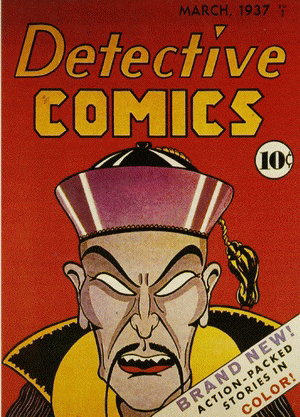 Major Malcolm Wheeler-Nicholson was in deep debt
with printers and his distributors (if not other people as well). Neither his More
Fun or New Fun Comics were selling. Harry Donenfeld owned both his distributor
(Independent News Company) and the
printers that did the covers for Wheeler-Nicholson’s comics. He
was in debt with Donenfeld for both companies. When Wheeler-Nicholson
tried to get more money for a new comic, Donenfeld and his accountant
Jack Liebowitz became partners of the company. They published the
already advertised Detective Comics #1 in March of 1937. The editor and
artist for this cover would be Vincent Sullivan. Inside the book would
be a bunch of racist stories using Chinese villains. This comic would
eventually become the name of the company. This title would do very
well for the company due to a particular character that appears in the
near future.
Major Malcolm Wheeler-Nicholson was in deep debt
with printers and his distributors (if not other people as well). Neither his More
Fun or New Fun Comics were selling. Harry Donenfeld owned both his distributor
(Independent News Company) and the
printers that did the covers for Wheeler-Nicholson’s comics. He
was in debt with Donenfeld for both companies. When Wheeler-Nicholson
tried to get more money for a new comic, Donenfeld and his accountant
Jack Liebowitz became partners of the company. They published the
already advertised Detective Comics #1 in March of 1937. The editor and
artist for this cover would be Vincent Sullivan. Inside the book would
be a bunch of racist stories using Chinese villains. This comic would
eventually become the name of the company. This title would do very
well for the company due to a particular character that appears in the
near future.
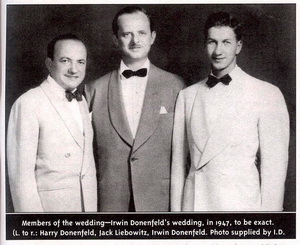 By 1938, Donenfeld would write off
Wheeler's debts for his half of the company to become
the sole owner of National Allied Publications. He then took on a friend/accountant in his distribution
business, Jack Liebowitz as a partner. The company was renamed National
Periodical Publications. Liebowitz stayed at the offices and headed the
accounting and creative part of DC while Donenfeld handled and
expanded the distribution though his company Independent News Co..
Also involved is Paul Sampliner who's family helped finance Independent News.
Donenfeld remained president of DC until his death in 1965. Liebowitz
remained in DC until 1970. When DC was bought by Warner Brothers he
moved to the Board of Directors of that company. He died in 2000.
Detective Comics is the company’s longest running comic book title.
This is due to another character who took over the title some time
later.
By 1938, Donenfeld would write off
Wheeler's debts for his half of the company to become
the sole owner of National Allied Publications. He then took on a friend/accountant in his distribution
business, Jack Liebowitz as a partner. The company was renamed National
Periodical Publications. Liebowitz stayed at the offices and headed the
accounting and creative part of DC while Donenfeld handled and
expanded the distribution though his company Independent News Co..
Also involved is Paul Sampliner who's family helped finance Independent News.
Donenfeld remained president of DC until his death in 1965. Liebowitz
remained in DC until 1970. When DC was bought by Warner Brothers he
moved to the Board of Directors of that company. He died in 2000.
Detective Comics is the company’s longest running comic book title.
This is due to another character who took over the title some time
later.
Behind the Scenes - The Odd Couple.
Harry Donenfeld and Jack Liebowitz have interesting histories
themselves. Harry came from a family that was involved in the printing business. During the prohibition
period he tried to make a go of it in the garment industry but didn't do so well. Along the way he
drank and gambled and had a very charismatic personality. He got to know the mob men behind the
booze and gambling. After he went to work for his family's printing industry, he used his connections
to print soft core porn books (among other magazines) that was distributed through mob channels. He
was likely using some of the Canadian timber the mob had imported as cover for the booze. From
there he went into publishing.
Jack Liebowitz was an accountant for a garment industry Union
that his father belonged to. He would leave the union after the mob got directly involved in running
it. Jack would end up working for Harry in the printing industry. The two had skills the other lacked.
Harry was the people person who liked to wheel and deal and people wanted to work with him. Jack was
the stable money manager that kept the business running smoothly and got Harry out of trouble when he
made bad deals. Jack would end up taking over DC Comics/Independent News and the licensing arm of the
company and turning it into a fully legit, respectable corporation.
 In May of 1936 two men named William Cook and
John Mahon
published The Comics Magazine #1. Cook and Mahon were former
disgruntled employees of Wheeler-Nicholson. They were the editor and
business manager of National Allied Publications. The two would
go on to form a publishing company called Comics Magazine but the title
changed and so did the ownership. Eventually it would be called Centaur
Comics. The Comics Magazine #1 would feature many of the same artists
that were in Wheeler-Nicholson’s books. Among them was Siegel and Shuster,
the two that would go on to create Superman. They renamed Dr. Occult to Mr.
Mystic and actually gave him supernatural powers, but no flashy
costume. The character would later appear in DC Comics More Fun #14,
with the story (called "The Koth and the Seven") continuing on from one
publishers book to the next. Another Siegel and Shuster character to
appear in this title was Federal Agent, later renamed Federal Men when
they also appeared in DC Comics. The Comics Magazine would change it's
name to Funny Pages with issue #6. The title would last until 1940
ending with issue #42.
In May of 1936 two men named William Cook and
John Mahon
published The Comics Magazine #1. Cook and Mahon were former
disgruntled employees of Wheeler-Nicholson. They were the editor and
business manager of National Allied Publications. The two would
go on to form a publishing company called Comics Magazine but the title
changed and so did the ownership. Eventually it would be called Centaur
Comics. The Comics Magazine #1 would feature many of the same artists
that were in Wheeler-Nicholson’s books. Among them was Siegel and Shuster,
the two that would go on to create Superman. They renamed Dr. Occult to Mr.
Mystic and actually gave him supernatural powers, but no flashy
costume. The character would later appear in DC Comics More Fun #14,
with the story (called "The Koth and the Seven") continuing on from one
publishers book to the next. Another Siegel and Shuster character to
appear in this title was Federal Agent, later renamed Federal Men when
they also appeared in DC Comics. The Comics Magazine would change it's
name to Funny Pages with issue #6. The title would last until 1940
ending with issue #42.



